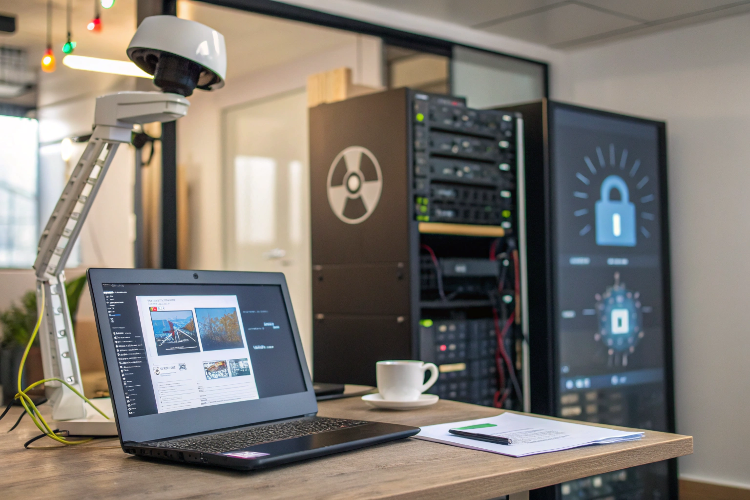Blog
The Role of Cybersecurity in a Remote Work Environment
Cybersecurity & Data Privacy ▪ 2025-03-11

The shift to remote work has transformed the modern workplace, offering flexibility, convenience, and cost savings. However, it has also introduced new cybersecurity challenges, making strong cybersecurity practices essential for individuals and businesses operating remotely.
Remote workers access company data from multiple locations and devices, increasing the risk of cyberattacks, data breaches, and identity theft. Hackers target remote employees using phishing scams, malware, unsecured Wi-Fi networks, and weak passwords to steal sensitive business information.
In this comprehensive guide, we’ll explore the role of cybersecurity in remote work, the top security risks, and the best practices for securing remote work environments.
Why is Cybersecurity Critical for Remote Work?
🚨 Cyber threats in remote work can lead to:
✅ Data Breaches – Hackers steal sensitive business and customer data.
✅ Financial Losses – Cybercrime costs companies millions in recovery efforts.
✅ Identity Theft – Attackers impersonate employees to commit fraud.
✅ Business Disruptions – Ransomware attacks can lock employees out of company systems.
✅ Regulatory Violations – Non-compliance with data security laws (GDPR, HIPAA, CCPA) can result in legal penalties.
💡 Example: The 2021 Colonial Pipeline cyberattack forced a major fuel pipeline to shut down, disrupting supply chains due to remote work security vulnerabilities.
🔗 Pro Tip: Strong cybersecurity policies protect both employees and businesses from cyber threats.
1️⃣ Key Cybersecurity Risks in Remote Work
🔹 1. Phishing & Social Engineering Attacks
✔ Cybercriminals send fake emails and messages, tricking remote workers into revealing login credentials.
✔ Attackers impersonate IT departments, HR, or executives to steal company data.
💡 Example: A remote employee receives a fake Microsoft Teams login request and unknowingly enters their credentials into a phishing site.
🔗 Pro Tip: Always verify sender emails and never click on suspicious links.
🔹 2. Unsecured Wi-Fi Networks
✔ Employees working remotely connect to public Wi-Fi at cafes, airports, or coworking spaces.
✔ Hackers use man-in-the-middle attacks to intercept sensitive data.
💡 Example: A hacker creates a fake "Starbucks Wi-Fi" network, capturing login credentials from employees.
🔗 Pro Tip: Use a Virtual Private Network (VPN) to encrypt internet traffic.
🔹 3. Weak Passwords & Credential Reuse
✔ Many remote employees reuse passwords across multiple work and personal accounts.
✔ Weak passwords make it easier for hackers to perform brute force and credential stuffing attacks.
💡 Example: The LinkedIn data breach exposed millions of user credentials, leading to business email compromises.
🔗 Pro Tip: Use strong, unique passwords and enable Multi-Factor Authentication (MFA).
🔹 4. Unsecured Personal Devices & Shadow IT
✔ Employees use personal laptops and mobile devices without IT oversight.
✔ Unauthorized third-party apps and unapproved software create security vulnerabilities.
💡 Example: Employees store confidential documents on personal Google Drives, increasing the risk of data leaks.
🔗 Pro Tip: Companies should implement a Bring Your Own Device (BYOD) security policy.
🔹 5. Ransomware & Malware Attacks
✔ Hackers exploit unpatched software and trick employees into downloading malicious attachments.
✔ Ransomware encrypts business files until a ransom is paid.
💡 Example: The WannaCry ransomware attack affected 230,000+ computers due to outdated Windows systems.
🔗 Pro Tip: Enable automatic updates and install enterprise-grade antivirus software.
2️⃣ Best Cybersecurity Practices for Remote Work
🔹 1. Implement Multi-Factor Authentication (MFA)
✔ MFA prevents unauthorized logins even if passwords are stolen.
✔ Use authenticator apps (Google Authenticator, Microsoft Authenticator, Authy) instead of SMS-based MFA.
💡 Example: Microsoft reports that MFA blocks 99.9% of automated cyberattacks.
🔗 Pro Tip: Enable MFA for all remote work applications, including email, cloud storage, and VPN access.
🔹 2. Use a VPN for Secure Internet Connections
✔ A Virtual Private Network (VPN) encrypts internet traffic and prevents hackers from spying on online activity.
✔ Remote workers should use a business-grade VPN (NordVPN, ExpressVPN, or Cisco AnyConnect).
💡 Example: Without a VPN, hackers on public Wi-Fi can steal login credentials through packet sniffing attacks.
🔗 Pro Tip: Never log into work accounts on public Wi-Fi without a VPN.
🔹 3. Enforce Strong Password Policies
✔ Require passwords with at least 12+ characters, numbers, symbols, and uppercase/lowercase letters.
✔ Encourage employees to use a password manager (Bitwarden, 1Password, or LastPass).
💡 Example: Instead of "Company123", use "Tq$9pLm&8vZ#P!".
🔗 Pro Tip: Change passwords every 90 days and never reuse old ones.
🔹 4. Secure Remote Access with Endpoint Protection
✔ Install enterprise-grade antivirus software on all remote work devices.
✔ Implement Endpoint Detection & Response (EDR) tools for real-time monitoring.
💡 Example: Companies use CrowdStrike or Microsoft Defender for Endpoint to detect malware on employee devices.
🔗 Pro Tip: Ensure that remote devices meet security compliance standards before connecting to company networks.
🔹 5. Train Employees on Cybersecurity Awareness
✔ Conduct regular cybersecurity training on phishing, password security, and remote work threats.
✔ Simulate phishing attacks to test employee awareness.
💡 Example: Google employees use security keys instead of passwords, making them highly resistant to phishing attacks.
🔗 Pro Tip: Require employees to complete cybersecurity training annually.
🔹 6. Regularly Backup Data
✔ Implement automated cloud backups to protect business data.
✔ Follow the 3-2-1 backup rule:
✔ 3 copies of data
✔ 2 different storage locations
✔ 1 offsite backup
💡 Example: Businesses that backed up data recovered quickly from ransomware attacks without paying ransom.
🔗 Pro Tip: Encrypt all backups to protect against cyber threats.

